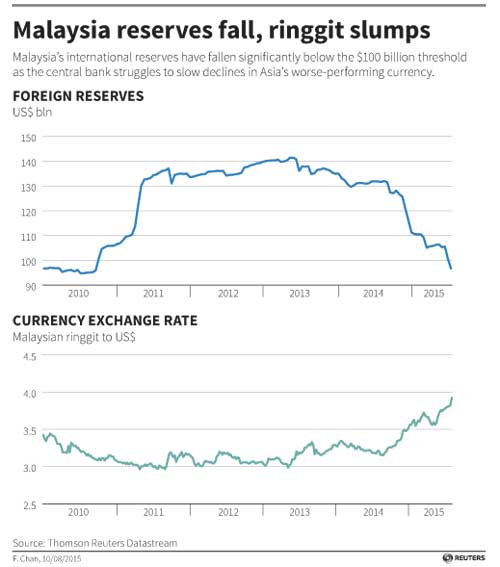Friday Jan 02, 2026
Friday Jan 02, 2026
Tuesday, 11 August 2015 00:01 - - {{hitsCtrl.values.hits}}
Reuters: Malaysia’s ringgit plumbed lows on Monday last seen during the Asian financial crisis 17 years ago, after a fall in foreign exchange reserves raised doubts over the currency’s ability to withstand pressure from political uncertainty and slower growth.
Investor sentiment toward Malaysia has deteriorated in recent weeks as Prime Minister Najib Razak became engulfed in a scandal over indebted state fund 1MDB.
The ringgit dropped to 3.9300 per dollar, compared to the previous close of 3.9220. It was the weakest level since Sept. 2 1998, the day before the government pegged it at 3.8000 per dollar to put a floor under the currency during the Asian financial crisis. Malaysia  lifted the peg in 2005.
lifted the peg in 2005.
Malaysia’s international reserves fell to $96.7 billion as of 31 July from $100.5 billion on 15 July, the central bank data showed on Friday.
Bank Negara Malaysia has been selling dollars and buying ringgit since June in an attempt to stem the ringgit’s slide as Najib defended himself against allegations of corruption, traders said.
“BNM is between a rock and hard place,” said Andy Ji, Asian currency strategist for Commonwealth Bank of Australia in Singapore, referring to Bank Negara Malaysia, the central bank.
“If it lets the ringgit fall, outflows will accelerate. To intervene, it will use up its FX reserves. So at the end, it needs to implement some capital controls.”
Despite the intervention, the ringgit is Asia’s worst-performing currency this year, having lost around 11% against the dollar.
The currency was earlier undermined by a slide in global commodity prices that had hurt export earnings and the government’s fiscal position.
Malaysia releases its second quarter GDP data on Thursday, amid rising concern over the outlook as industrial production in June rose 4.3% from a year earlier, slightly short of market expectations.
The ringgit’s weakness reduced appetite among foreign investors for Malaysian assets. Kuala Lumpur stocks fell 2% to their lowest since April 2013. Five-year government bond yield jumped to 3.856%, its highest since Jan. 16.
“It now becomes a question of when does the bleeding stop?” asked Stephen Innes, senior trader for FX broker Oanda in Singapore.
“The Bank Negara Malaysia agencies continue to sell USD to temper the move higher, but we are questioning, at what cost can they continue to do so, as further drops in reserves will likely accelerate the move higher?” Innes added.